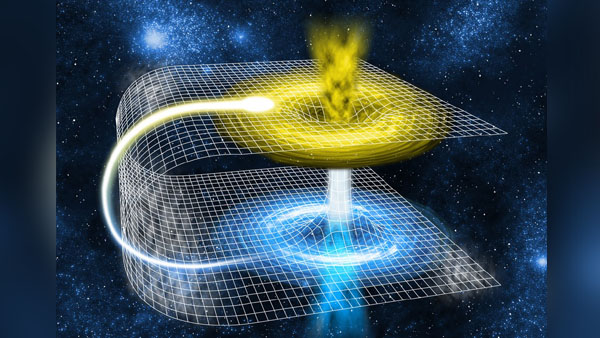By Satyabrat Borah
Imagine standing under a starlit sky, gazing at the vastness of the universe, and wondering if there’s a secret passageway that could whisk you across galaxies or even through time itself. This is the allure of a wormhole, a concept that feels like it’s been plucked straight from the pages of a science fiction novel but is rooted in the hard mathematics of physics. A wormhole is like a cosmic tunnel, a shortcut that connects two distant points in space or time, bending the fabric of the universe to make the impossible seem tantalizingly within reach. For anyone who’s ever dreamed of exploring the stars or unraveling the mysteries of existence, wormholes are a captivating idea that blends the boundaries of science and imagination.
The story of wormholes begins with Albert Einstein, whose theory of general relativity revolutionized our understanding of the universe. In 1915, Einstein proposed that space and time are not separate but interwoven into a four-dimensional fabric called spacetime. This fabric isn’t rigid.It can bend, stretch, or warp under the influence of mass and energy, like a trampoline sagging under the weight of a bowling ball. Massive objects like stars or black holes create deep dents in this fabric, and it’s within this framework that wormholes emerge as a possibility. Think of spacetime as a vast sheet, and a wormhole as a tunnel that punches through it, connecting two far-apart points. If you could fold that sheet so two distant spots touch, a wormhole would be the bridge between them, allowing you to step from one to the other without crossing the vast distance in between.
The idea first took shape in 1916 when Austrian physicist Ludwig Flamm found a curious solution to Einstein’s equations. He suggested that spacetime could curve in such a way that two regions might be linked by a tunnel-like structure. In 1935, Einstein and his colleague Nathan Rosen fleshed out this idea, describing what became known as the Einstein-Rosen bridge. This was a purely theoretical construct, a mathematical curiosity that hinted at the possibility of connecting two points in spacetime. However, it wasn’t until 1957 that physicist John Wheeler coined the term “wormhole,” likening it to the tunnel a worm might bore through an apple to get from one side to the other. The name stuck, evoking a vivid image of a passageway through the cosmos.
But what exactly is a wormhole? Picture a tunnel with two openings, or “mouths,” each located at a different point in space or time. These mouths could be light-years apart, or even in different universes, yet the tunnel offers a shortcut. If you stepped into one mouth, you might emerge instantly at the other, bypassing the normal rules of distance and time. It’s the ultimate cheat code for cosmic travel, making journeys that would take millions of years at the speed of light possible in mere moments. The catch? No one has ever observed a wormhole, and their existence remains speculative, grounded only in the equations of general relativity.
The science behind wormholes is mind-bending. According to Einstein’s theory, they could exist, but keeping one open and stable is a monumental challenge. A wormhole’s throat is naturally unstable, prone to collapsing the moment it forms, like a straw pinched shut at one end. To hold it open, physicists propose the need for something called “exotic matter” or “negative energy.” Unlike ordinary matter, which has positive mass and attracts other objects through gravity, exotic matter would have negative mass, creating a repulsive force to counteract the wormhole’s tendency to collapse. This sounds like science fiction, but small amounts of negative energy have been observed in quantum physics, such as in the Casimir effect, where certain conditions cause particles to behave as if they have negative energy. Still, generating enough of this exotic matter to stabilize a wormhole large enough for a spaceship to pass through is far beyond our current technology.
Then there’s the question of time travel. Wormholes aren’t just about crossing space; they could, in theory, connect different points in time. Imagine one mouth of a wormhole in 2025 and the other in 2050. Step through, and you could find yourself in the future or if the setup allows, the past. This possibility raises all sorts of paradoxes, like the famous “grandfather paradox”: if you traveled back in time and prevented your own birth, how could you exist to travel back in the first place? These conundrums make physicists cautious, with some suggesting that the laws of physics might prevent time travel through wormholes to avoid such contradictions. Others, like Stephen Hawking, have proposed that quantum effects could make wormholes too unstable for practical use, effectively closing the door on time travel shenanigans.
Despite their theoretical nature, wormholes have captured the public’s imagination, thanks in large part to popular culture. Movies like “Interstellar” depict wormholes as glowing, traversable portals leading to distant galaxies, complete with stunning visuals of swirling light. In the film, a wormhole near Saturn allows astronauts to reach a far-off star system, a plot point grounded in real physics thanks to the input of physicist Kip Thorne. Similarly, Marvel’s “Thor” uses wormholes (called the Bifrost) to transport characters across realms. These portrayals, while dramatized, have made wormholes a household name, sparking curiosity about whether such cosmic shortcuts could one day become reality.
Yet, the reality is far more complex. If wormholes exist, they might be microscopic, existing only at the quantum level, far too small for anything larger than a particle to pass through. Creating or finding a macroscopic wormhole would require unimaginable amounts of energy, possibly equivalent to the output of entire stars. Even if we could create one, the journey might be perilous. The intense gravitational forces inside a wormhole could tear apart anything that enters, and there’s no guarantee you’d emerge intact on the other side. Plus, there’s the question of where the other mouth leads. Would it connect to a habitable planet, a black hole, or an entirely different universe with its own laws of physics?
For someone pondering wormholes from a place like Assam, where the night sky over the Brahmaputra River feels like a window to infinity, the concept is both thrilling and humbling. It’s a reminder of how vast the universe is and how small our place in it seems. Wormholes feel like a modern myth,a tale of cosmic bridges that connect the impossible. They challenge us to think beyond the ordinary, to imagine a future where humanity might leap across the stars or glimpse the past.
Wormholes also inspire philosophical questions. If we could travel through one, what would it mean for our understanding of existence? Would we find other civilizations, or would we confront the limits of our own technology and imagination? For now, wormholes remain a tantalizing possibility, a blend of rigorous science and boundless wonder. They remind us that the universe is full of mysteries waiting to be explored, and even if we never step through a wormhole, the act of dreaming about them pushes us to keep asking questions. As we look up at the stars, we’re not just seeing light from distant suns but imagining the hidden paths that might connect us to them. Wormholes, whether real or not, are a testament to humanity’s unquenchable curiosity, urging us to keep searching for the unknown.




